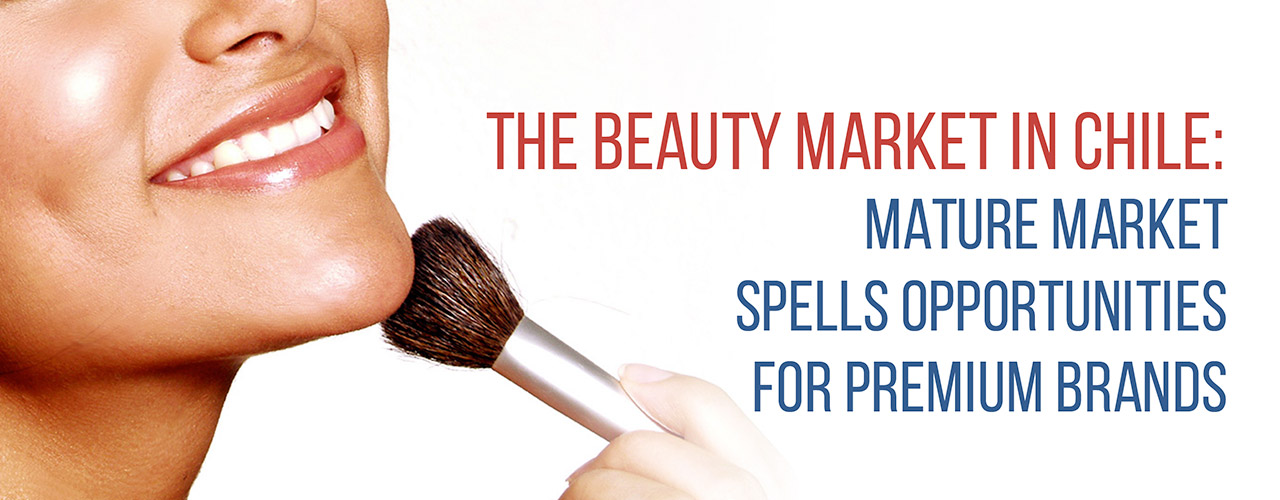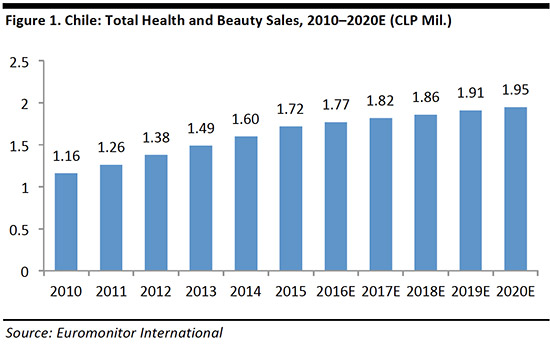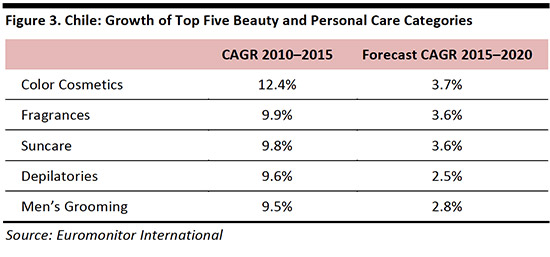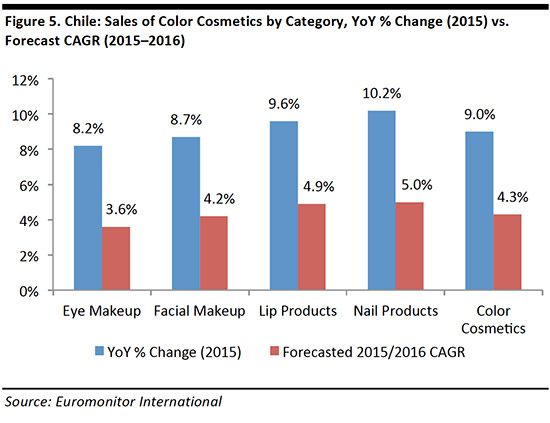
The Beauty Market in Chile: Mature Market Spells Opportunities for Premium Brands

KEY POINTS
- Women in Chile are increasingly willing to pay higher prices for beauty and personal care goods that offer diversified benefits or have recognizable, premium brand names.
- Chileans tend to look for convenience when buying beauty and personal care products; they often purchase beauty items while shopping for groceries or other everyday goods rather than making a separate trip to a beauty specialist store.
- Premium beauty products are becoming more popular in Chile, and more consumers are buying them at department stores such as Falabella and Ripley.
- Chileans tightened their spending on expensive facial creams and perfumes in 2015, but increased their purchases of lip products and facial makeup. This was likely because women saw buying the smaller, more affordable items as a way to treat themselves despite shrinking disposable incomes.
- Chileans have a generally positive view of private-label products, as the Chilean consumer is not particularly brand loyal, but tends to be price conscious.
OVERVIEW
Chile has been repeatedly recognized as one of the most attractive markets in Latin America for international retailers. Chile is a high-income economy, according to the World Bank, and is known for having one of the most stable and prosperous economies in all of Latin America. In 2015, Chile’s population totaled 17.9 million, and it has grown at only about 1% per year for the past 10 years. The country’s GDP grew by 1.9% in 2014 and by 2.1% in 2015, when it reached US$240.2 billion.
Due to the maturity of Chile’s economy, the stability of its middle class and the sustained positive economic growth it has seen since 2000 (excluding 2009), Chile’s beauty market is relatively mature compared with those of other Latin American countries.
In 2014, Chilean men and women spent an average of US$168 on beauty products, 30% more than the US$128 spent by the average Latin American consumer, according to Chilean newspaper El Mercurio.

BEAUTY AND PERSONAL CARE
The beauty and personal care market is highly developed in Chile compared with other countries in Latin America. Accordingly, market growth is slowing in the country, although Euromonitor International expects the market to continue to see positive growth through 2020. Per-capita category sales are higher in Chile than in other Latin American countries, but there are still pockets of beauty and personal care that present opportunities for growth.
Women are increasingly entering the workforce in Chile, and rising levels of education have enabled women to become increasingly employed in higher-paying jobs. Birth rates are also on the decline, and many women are delaying pregnancy until later, which results in them having stronger purchasing power. Thus, Chilean women are increasingly willing to pay higher prices for beauty and personal care goods that offer diversified benefits or have recognizable, premium brand names.
 Many countries in Latin America have seen impressive sales growth in categories such as fragrances and men’s grooming products. Chile is trending differently; according to the Chamber of Cosmetics in Chile (Cámara de la Cosmética de Chile), makeup is the fastest-growing beauty category in the country.
Many countries in Latin America have seen impressive sales growth in categories such as fragrances and men’s grooming products. Chile is trending differently; according to the Chamber of Cosmetics in Chile (Cámara de la Cosmética de Chile), makeup is the fastest-growing beauty category in the country.
Men’s grooming products have seen impressive growth in Chile in the past few years as men have adopted more involved personal care routines. Currently, there are new men’s products on the market in the fragrances, toiletries and shaving categories, although men’s options for haircare, bath and shower, and skincare are still limited, as men often opt for unisex options in these categories.
 DISTRIBUTION CHANNELS
DISTRIBUTION CHANNELS
According to an article on Chilean lifestyle website BioBioChile.cl, Chilean women consider multiple factors when choosing where to shop. The article cites an In-Store Media/Ipsos survey that found that 76% of Chilean women think product variety is important when choosing where to shop, while 56% think travel distance to the shopping location matters and 51% factor prices into their decision when choosing where to shop.
Chileans tend to buy their beauty and personal care goods when convenient, such as while shopping for groceries or other everyday goods; they are less inclined than consumers in some other markets to make a separate trip to a beauty specialist store. According to Euromonitor, Chileans most often buy beauty and personal care items at drugstores/parapharmacies or chemists/pharmacies.
In Chile, there are three main pharmacy chains—Farmacias Cruz Verde, Salcobrand and Farmacias Ahumada. The parent company of the Cruz Verde chain also owns beauty specialist retailer Maicao, and Salcobrand bought the DBS Beauty Store chain in 2014, so, the market is concentrated among very few players. Premium beauty products are becoming more popular in Chile, however, and more consumers are buying them at department stores such as Falabella and Ripley.

Chile differs greatly from other Latin American countries in that stores are the dominant distribution channel for beauty and personal care products. In most of Latin America, direct selling is the dominant channel. For example, in 2015, direct selling accounted for 25.2% of beauty and personal care sales in Brazil, but for only 15.4% in Chile, largely due to Chile’s smaller population. Direct selling is on the decline, however, and the trend is likely to continue. Internet retailing still remains largely insignificant in terms of Chilean beauty product sales, although, as innovations in virtual reality that enable consumers to “try on” products before they buy continue to improve, the channel will likely grow to account for a more significant proportion of sales.
BEAUTY TRENDS
Chile’s economic growth began to slow in 2015, causing consumers to tighten their spending overall. However, some beauty product categories have seen the inverse effect of this slowdown: as spending on expensive facial creams and perfumes slowed in Chile, spending on lip products and facial makeup actually increased year over year. This was likely due to the fact that women saw these smaller, more affordable items as a way to treat themselves despite their shrinking disposable incomes. Lip gloss and nail products posted the highest growth in 2015 due to their relative low unit cost and ease of application.

The growth of color cosmetics sales is expected to slow immensely in 2016 in tandem with the slowing economy; Bloomberg estimates that the Chilean economy will grow by only 1.25%–2.25% this year.
Chileans have a generally positive view of private-label products. According to a 2014 Nielsen survey, 73% of consumers in the country say that private labels are a good alternative to name brands.
While the beauty and personal care market is far more developed in Chile than it is in other Latin American markets, the country presents a number of opportunities for beauty and personal care companies, particularly related to premium products. As the country’s economic growth begins to slow, the color cosmetics industry will likely continue to grow, albeit more slowly.
